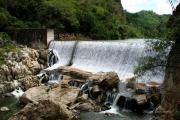Touted as the Arts Capital of the Philippines, the town of Angono is not only known for its admirable artwork by extraordinarily talented artists. This town in Rizal is also known for Higantes Festival where thousands of visitors every year gather to witness and be part of the festivities which stretch from days on end.
In honor of San Clemente, the patron saint of the fishermen, the town of Angono in Rizal celebrates the Higantes Festival. The feast is also known as the Feast of San Clemente where the image is carried by male devotees during a procession accompanied by "pahadores," devotees dressed in colorful local costumes or fishermen's clothes, wearing wooden shoes and carrying boat paddles, fish nets, traps, etc., and "higantes," paper-mâché giants measuring 10-12 feet in height and 4-5 feet in diameter. This street event ends in a procession to Laguna de Bay until the image is brought back to its sanctuary.
Faces of Higantes Festival
The festival is part of a two-week long celebration that includes a Misa Cantada (a special sung mass), novena, song and dance contests, fried "itik" festival and cooking competition, a 5k Fun Run, on-the-spot painting contest, art exhibit, job fair, bingo and videoke challenge, and of course, the highlights of the festivities -- the Race of the Higantes and the Procession of the Pagoda.
A procession is held throughout the town, with the images brought to the banks of the Laguna de Bay where they would be enshrined in a floating pagoda for a fluvial procession until the event concludes with the image of San Clemente returned to the church.
During the procession, thousands of revelers splash water on unsuspecting participants and onlookers. They use water bottles, squirt guns, and even drinking glasses, spraying water on everyone passing by.
Glories of the Past
More than a century ago, when Angono was still a Spanish hacienda, the hacienda owners prohibited the townspeople from holding any celebrations. Aside from the costly preparation, they also wanted to restrict pagan festivities. They allowed only one annual celebration -- the town fiesta in honor of its patron saint, San Clemente.
The townspeople took advantage of this sole festivity, prepared lots of food, wore colorful costumes, and held a big procession featuring big paper-mâché caricatures of their Spanish landlords -- an art form imported from Mexico by Spanish friars. These multi-colored, humongous, comical and sometimes scary 12-footers were called "Higantes" or giants.
Before, only two or three higantes were made, representing a "mag-anak" (father, mother and son/daughter). In 1987, Mr. Perdigon Vocalan suggested that all thirteen barangays must have two or three higantes, symbolizing the barangay’s industry or personality. This idea materialized with the help of the Department of Tourism and Provincial Tourism Office. Since then, the town’s folk maintained this practice and elevated it into an art form. This colorful celebration boasts of around 40 different higantes representing each barangay and attracting local and foreign tourists.
Making the Higantes
In the past, the heads of the higantes were made of paper-mâché. A model of the head was carved out of clay. Once the clay mold was dry, strips of newspapers would be glued together, one strip on top of the other. Once the right thickness was achieved, the paper-mâché would be cut open to separate it from the mold and the hollow head was glued back together, ready to be painted with the details of the face.
Bamboo strips or yantok were used as the skeleton frame for the body. It would then be covered with yards of cloth resembling their characters. The head was attached to the body and a person could go inside and carry the higante around.
In modern times, clay was changed into plaster of Paris and resin. Tougher material like fiberglass is applied to the mold instead of paper and thin strips of aluminum are used for the body frame for durability purposes.
Getting There
- The province of Rizal is 110 kilometers south of Manila. It is accessible by land transportation from Metro Manila and the neighboring provinces of Southern Tagalog and Central Luzon.
- Buses, varied public utility vehicles and the metro rail system with stations at Crossing/EDSA in Mandaluyong City, Robinson’s Galleria in Ortigas Avenue, Quezon City and Farmer’s Market in Cubao, Quezon City ply the routes to Antipolo, Taytay, Cainta, Binangonan, Angono, Tanay and other towns in Rizal.










